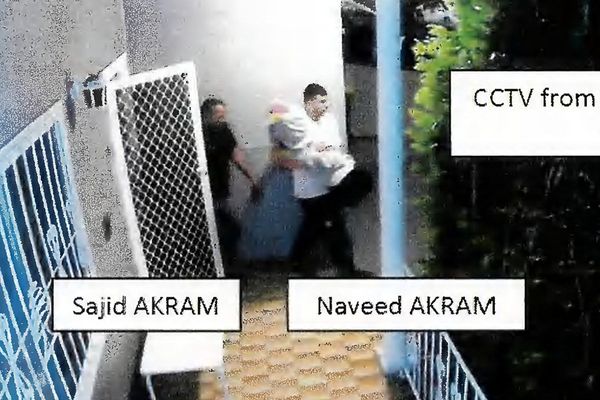
Ancient artefacts from Gaza – amphorae, statues, mosaics, funerary steles and more – tell the story of 5,000 years of a civilisation, in a Paris exhibition that seeks to preserve a heritage on the brink of erasure.
Assembled in just four and a half months, the exhibition, entitled "Treasures Rescued from Gaza – 5,000 Years of History", at the Institut du Monde Arabe honours Gaza’s rich past and looks to protect what's left of a cultural legacy that has endured empires, invasions and now war.
“More than ever, especially since 7 October and the destruction that followed, Gaza deserves to have its history told,” said museum president Jack Lang, a former French culture minister.
His words resonate in the low-lit basement gallery, where the rescued artefacts are displayed beneath the building’s 240 ornate mashrabiyas, or screens.
A civilisation under siege
The exhibition features some 130 rare pieces spanning from the Bronze Age to the present.
The artefacts were placed in storage at the Geneva freeport in 2007, following an exhibition at the Museum of Art and History in Switzerland.
They were meant to be returned to Gaza for display in a planned 20,000-square-metre museum backed by Unesco, the United Nations' cultural agency, but the project was abandoned as the situation in Gaza deteriorated.
Their lengthy exile may have saved them – unlike so much left behind in Gaza, these artefacts survived the Israeli airstrikes.
Long before the destruction seen today, Gaza was a thriving port and a key stop on caravan routes, linking Asia, Africa, Arabia and the Mediterranean. For thousands of years, it was a crossroads of civilisations and ideas – a place where cultures met and flourished.

Rescued treasures
Displayed on wheeled trolleys in a space that evokes a storage depot, the rescued artefacts are shown in a setting that reflects their fragility and displacement.
One section maps the destruction of archaeological sites in Gaza damaged in Israeli bombing raids, using satellite images and research compiled by several groups. Alongside it is a record of recent discoveries, offering a glimpse of what has been lost – and what remains.
These are not symbolic treasures: they were physically rescued from Gaza and nearly lost.
'I want a loud death': Cannes Film Festival to honour slain Gaza journalist
“Nothing is worse than abandonment and forgetting,” said Lang. “This exhibition, which I would describe as a matter of public salvation, pays tribute to Gaza – vibrant and wonderfully young.”
The collection is brimming with extraordinary pieces: a tilted marble Aphrodite, a royal oil lamp that spent more than 2,000 years underwater, a bronze Osiris, an alabaster vase from Egypt, small figurines, a cavalryman’s head from the 5th century BCE, and a vast Byzantine mosaic alive with animals and people.

Layers of history
Excavations in Gaza began in the mid-19th century before gaining pace under the British Mandate (1922–1948). They were then further expanded after the Oslo Accords in 1993.
That’s when a Palestinian Antiquities Service was created, later teaming up with the French Biblical and Archaeological School of Jerusalem to document and protect sites across the enclave.
At the Institut du Monde Arabe, a cultural centre dedicated to Arab civilisation and heritage, visitors can browse early 20th-century photographs showing digs and ruins across Gaza’s 365 square kilometres – visual proof of a land layered with history.
In January 2024, three months into the latest Israeli offensive, the Saint Hilarion Monastery was added to the Unesco World Heritage List under an emergency procedure – the first site in Gaza to receive that status.
By 25 March, 2025, Unesco had identified damage to 94 cultural sites using satellite imagery: 12 religious buildings, 61 historic or artistic structures, seven archaeological sites, six monuments, three collections of cultural artefacts and one museum.

A personal mission
Much of the exhibition draws on the collection of Jawdat Khoudary, a Palestinian builder who began saving artefacts found during construction work in Gaza. In 2008, he opened a private museum that housed more than 4,000 pieces.
Only the ones stored in Switzerland survived. The rest have been destroyed.
Now a refugee in Egypt, Khoudary donated the surviving objects to the Palestinian Authority. They form the heart of the Paris exhibition – remnants of a collection that was almost entirely wiped out.
His donation ensures that at least part of Gaza’s archaeological heritage is preserved.
The idea that cultural memory shapes national identity runs throughout the exhibition, echoing the words of former Palestinian leader Yasser Arafat in the January 1999 issue of Dossiers d’Archéologie, a French archaeology magazine.
“However great the suffering and however long the road to freedom and dignity, a people exists only through an awareness of being the heir to a history that gives it identity, places it in the world and ensures its survival,” Arafat wrote.
At a time when Israel is blocking humanitarian aid to Gaza and denying the existence of a humanitarian crisis, this exhibition offers a different message: one of memory, identity and survival.
"Some of its treasures will survive this war – and ensure that Gaza is not completely wiped off the map,” said Lang.
► "Treasures Rescued from Gaza: 5,000 Years of History" is on display until 2 November, 2025 at the Institut du Monde Arabe in Paris.
This story was adapted from the original version in French by RFI's Anne Bernas







